About the Company (As of May 2023)
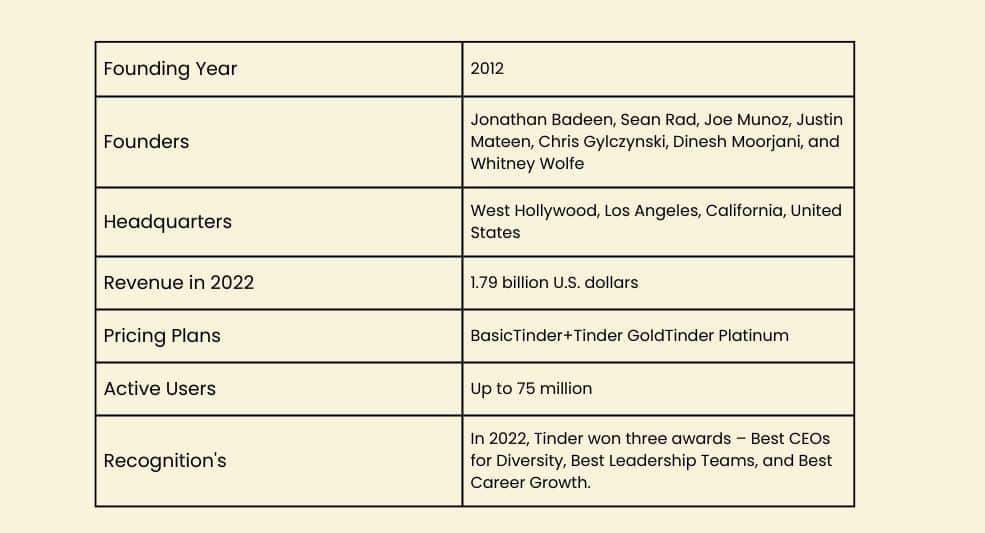
A Brief History of Tinder
Tinder is a popular mobile dating application that was launched in 2012. It was founded in a startup incubator called ‘Hatch Lab’ by Sean Rad, Jonathan Badeen, Justin Mateen, Joe Munoz, Dinesh Moorjani, and Whitney Wolfe Herd.
The app reached the value of $1 billion in 2014, i.e., within 2 years of launch, and by 2022, Tinder’s revenue had reached $1.79 billion. As for 2023, the company reported revenue of $787 million in the first quarter and forecasted revenue between $805 million – $815 million in the current quarter.
Who Owns Tinder?
Tinder is owned by Match Group, an InterActiveCorp subsidiary (IAC).
Tinder Mission
Tinder’s mission is to foster meaningful connections, embrace diversity and empower individuals to express themselves authentically. With innovation, inclusivity, and safety as priorities, they aim to revolutionize modern dating, providing a global community for people to discover and engage with others who share their interests and values.
The Business of Love: How Tinder Rakes in Revenue?
Do you know that when the Match Group took Tinder public, the app saw an increase in direct revenue, amounting to a whopping $1.79 billion in 2022?
As you navigate through a sea of profiles, you might wonder, “How does Tinder make money?” Well, get ready to uncover the secrets behind Tinder’s revenue-generating strategies and learn how this popular dating app has turned love into profits.
Subscription Model:
One of the primary ways Tinder makes money is through its subscription model. While Tinder offers a freemium version to its users, it comes with limited features. As a result, users who want to leverage advanced features opt for subscription plans.
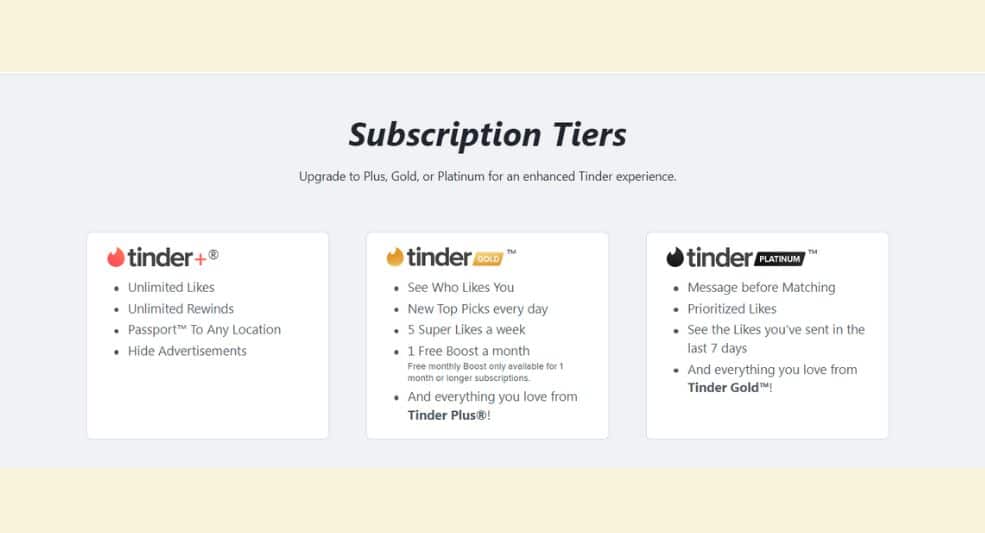
Premium Plan:
The app offers a premium subscription called Tinder Plus, which provides users with additional features and functionalities. These features include the ability to swipe unlimited times, access to “Passport” (which allows users to change their location and match with people from different cities), the option to “Rewind” and undo a left swipe, and hide advertisements.
Tinder Gold:
The Tinder Gold tier includes all the features of Tinder Plus, along with a few extras. Tinder Gold introduces the “Likes You” feature, which allows users to see who has swiped right on their profile before they swipe on others.
This saves time and enhances the overall user experience. In addition, subscribers receive a monthly free boost, increasing profile visibility, and enjoy daily top picks for curated matches.
Tinder Platinum:
Tinder Platinum is the ultimate upgrade for those seeking unparalleled dating experiences. Alongside all the features of Tinder Gold, Platinum provides users with the exclusive benefit of prioritized matching, allowing them to be among the first to see new potential matches.
With the power to message before matching and access to top picks, it’s the ultimate way to elevate your dating game and make the most out of your Tinder experience.
Advertising and Sponsored Profiles:
Another significant revenue stream for Tinder is advertising. The app leverages its vast user base and user data to provide targeted advertisements to its users. These ads can appear in various forms, including banners, sponsored profiles, and interstitials.
Tinder’s advertising platform allows brands and businesses to reach a highly engaged audience with user-tailored campaigns. Tinder ensures that these ads are seamlessly integrated into the user experience, making them less intrusive and more engaging.
In-App Purchases:
In addition to subscriptions and advertising, Tinder monetizes its platform through in-app purchases. The app offers virtual currency called “Tinder Coins” or “Super Likes” that users can buy to enhance their experience.
Tinder also occasionally introduces limited-time promotions and special features that users can purchase for a fixed duration. These in-app purchases provide users with a sense of exclusivity and customization while generating additional revenue for Tinder.
Partnerships and Collaborations:
Furthermore, Tinder has established partnerships and collaborations with other companies to further monetize its platform. For example, the app has collaborated with popular brands for co-branded marketing campaigns.
These campaigns often include exclusive discounts, giveaways, or events, giving Tinder users added value while creating promotional opportunities for the partner brands.
Additionally, Tinder has partnered with music streaming services and integrated music features into the app. Users can connect their Spotify accounts to their Tinder profiles, allowing them to showcase their music preferences and even share songs with potential matches.
Such partnerships not only enhance the user experience but also create opportunities for cross-promotion and monetization.
Tinder Business Model Canvas
Customer Segment
- Young Adults: Tinder primarily targets young adults who are interested in building romantic relationships. Its platform caters to individuals seeking meaningful connections and companionship.
Value Propositions: What Makes Tinder Unique
- Global Assistance in Building Meaningful Romantic Connections: Tinder aims to assist individuals worldwide in establishing more fulfilling romantic relationships. By leveraging its platform, Tinder seeks to enhance the process of connecting with potential partners and creating lasting bonds.
- Overcoming Physical and Mental Barriers in Relationship Formation: Tinder recognizes and addresses the diverse challenges individuals face when forming relationships, including both physical and mental obstacles. By providing a supportive environment, Tinder aims to help users overcome these barriers and navigate the complexities of dating.
- Intelligent Matchmaking for Rational Pairings: Tinder’s platform incorporates intelligent algorithms and data-driven approaches to ensure that users are matched in a rational and compatible manner.
By leveraging advanced technology, Tinder strives to enhance the quality of matches and increase the potential for successful relationships.
Tinder Channels
Google Play Store The Google Play Store serves as a direct channel for users to access and download the Tinder mobile application on their Android devices. Users can visit the Play Store, browse through Tinder’s app listing, read reviews, view screenshots, and download the app directly to their smartphones or tablets.
iOS App Store – Similar to the Google Play Store, the iOS App Store acts as a direct channel for iPhone and iPad users to discover, download, and install the Tinder app on their Apple devices.
Users can visit the App Store, explore Tinder’s app page, read user ratings and reviews, preview screenshots, and directly download the app to their iOS devices.
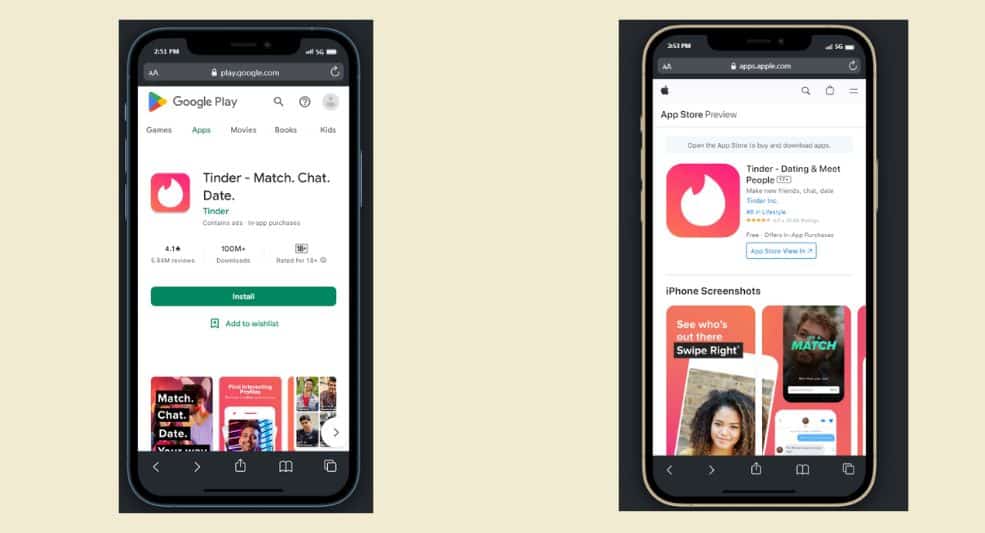
Blog – Tinder maintains an official blog where they share news, updates, and feature announcements related to their dating platform. The blog serves as an indirect channel for users to learn more about Tinder’s latest developments, new features, success stories, dating tips, and more.
It helps to engage existing users, attract potential users, and create a sense of community within the Tinder ecosystem.
Website – Tinder’s official website www.tinder.com acts as a direct channel for users to access information about the platform and sign up for a Tinder account.
The website provides an overview of Tinder’s features, functionality, subscription options, safety guidelines, and success stories. Users can navigate the website, learn more about the platform, and create an account directly from the site.
Press – Tinder leverages press coverage as an indirect channel for acquiring new users. They collaborate with media outlets, journalists, and influencers to generate publicity and reach a wider audience.
Articles, interviews, and features about Tinder in newspapers, magazines, online publications, and TV shows help to increase brand visibility, build credibility, and attract new users to the platform.
Social media – Tinder maintains a strong presence on various social media platforms, including Facebook, Instagram, Twitter, and YouTube. These social media channels serve as indirect channels for engaging with existing users, promoting new features, sharing success stories, and showcasing the Tinder brand.
Users can follow Tinder’s official social media accounts, interact with posts, share content, and even participate in promotional campaigns.
Other indirect channels – In addition to the channels mentioned above, Tinder may utilize other indirect channels such as influencer marketing, email marketing, content marketing, and online advertising to acquire new users.
These channels involve collaborating with popular influencers or celebrities, sending targeted emails to potential users, creating engaging content such as videos or blog posts, and running advertising campaigns across various online platforms to reach a wider audience.
These channels help Tinder to expand its user base and increase brand awareness.
Customer Relationship
Profiles: Tinder allows users to create profiles that showcase their interests, hobbies, and personal preferences. These profiles serve as a medium for users to express themselves and provide a snapshot of their personality.
By presenting a comprehensive picture, Tinder encourages users to engage with each other based on shared interests and common ground.
User Suggestions Based on Interest and Location: Tinder employs a sophisticated algorithm that suggests potential matches to users based on their interests and location.
This personalized recommendation system analyzes user preferences, including hobbies, activities, and mutual connections, to present relevant profiles. By tailoring suggestions to individual preferences, Tinder aims to increase the likelihood of meaningful connections between users.
A Match for People Interested in Each Other’s Profiles: When two users express mutual interest by swiping right on each other’s profiles, Tinder creates a “match.” This mutual interest indicates that both individuals are open to initiating a conversation and exploring the possibility of a relationship.
By facilitating matches, Tinder provides a starting point for users to engage in conversations and get to know each other better.
Swipe Left or Right to Reject or Accept a Suggestion: Tinder’s interface revolves around a simple and intuitive swiping mechanism. Users are presented with profiles one at a time and can swipe left to reject or swipe right to express interest.
This “swipe culture” enables users to quickly browse through profiles, making the process efficient and engaging. By providing a seamless user experience, Tinder aims to facilitate connections based on mutual attraction and compatibility.
Tinder Revenue Streams
Tinder, a widely used dating application, has multiple revenue streams that ensure its profitability. It has leveraged technology to bring people together, but also to generate substantial income from various sources.
In-App Purchases: In September 2022, Tinder’s in-app purchase revenue was approximately $76.45 million worldwide across both the App Store and Google Play. The majority of this revenue came from North and Latin America.
These in-app purchases often consist of premium features that enhance users’ experiences, such as Super Likes and Boosts.
Subscriptions: Tinder offers three tiers of premium subscriptions—Tinder Plus ($7.99/ month), Tinder Gold ($24.99/month), and Tinder Platinum ($29.99/month). Half-yearly and yearly plans are also available.
Each tier offers an array of additional benefits like unlimited swipes, rewinds, and more visibility to other users. Around 6.2 million users have subscribed to these premium memberships, indicating a steady stream of revenue for the company.
On taking the Tinder app public, the number of paying subscribers reached 10.9 million, marking a 10% year-on-year increase.
Sponsored Sports: Tinder has also ventured into sports sponsorships. For instance, a sponsorship deal with Manchester United served dual purposes: improving brand awareness and affinity while also promoting the growth of Tinder’s Plus memberships.
Advertisements: Advertising is another critical component of Tinder’s revenue model. Brands like Bud Light (U.S. based Beer brand) were the first to experiment with video advertisements on the platform.
In an innovative campaign, users were encouraged to swipe right for a chance to win free event passes. These ad campaigns not only promote the brands but also keep the application free for a significant number of users.
Moreover, Tinder has found a niche for social cause campaigns. For example, the app has been used to promote women’s empowerment through a campaign launched on Women’s Day.
Amnesty International also used Tinder to increase awareness against forced marriages. Such campaigns allow the platform to maintain a social footprint while simultaneously boosting its user engagement and reputation.
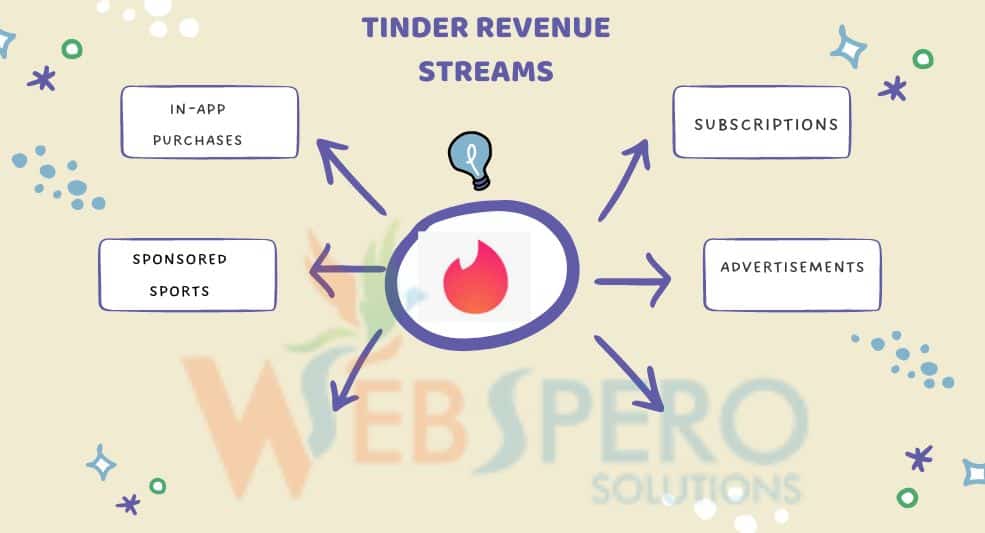
Key Resources
Tinder’s business model is fueled by several key resources that enable it to provide a unique and popular dating platform for users. These key resources include:
Social Data: Tinder’s primary resource is the social data it gathers from its users, which spans over 190 countries and is available in 56 languages. With over 75 million active users monthly, this social data is incredibly diverse and vast, making it invaluable for the app’s matchmaking process.
User profiles, preferences, behavior patterns, mutual interests, and engagement history are analyzed using advanced algorithms to suggest potential matches.
The global spread of Tinder’s user base means the app has a broad dataset to draw from, further refining and enhancing its matchmaking capabilities. This extensive reach and use are what make social data a crucial resource for Tinder.
GPS Technology: GPS technology plays an essential role in Tinder’s functionality. It allows the app to find potential matches within a user’s geographical area, which is a critical factor in the matchmaking process.
By knowing where users are located, Tinder can help users connect with others in their local community or, if they choose, from around the world.
Network: Like all social platforms, Tinder’s value is intrinsically tied to its network. The larger the user base, the higher the chance of making suitable matches for each user, thus enhancing the platform’s overall value. This is sometimes referred to as network effects.
Facebook API Data: Tinder initially used Facebook API data for user authentication and pulling demographic data, which helped the app populate user profiles quickly and maintain a level of security and legitimacy.
This practice may evolve or change based on privacy laws and Facebook’s data-sharing policies.
The Platform or App: The app itself, with its simple and intuitive interface, is a significant resource. It allows users to quickly understand and engage with the functionality, swipe through profiles, and communicate with matches.
Regular updates and maintenance of the platform ensure its usability and customer satisfaction.
Seed Funding: Tinder’s financial trajectory is marked by robust and consistent investor support. The company has raised a total of $50M in funding over three rounds. Their latest round of funding was a Venture – Series Unknown round that took place on October 10, 2017.
These funds have been instrumental in enabling the company to scale its operations and cement its place as a leading player in the online dating industry.
Two major investors have provided the bulk of this funding: Benchmark and IAC. Their financial backing underscored the faith of venture capitalists and industry insiders in Tinder’s innovative platform and promising growth trajectory.
Not only a recipient of funding, Tinder has also shown interest in fostering innovation and entrepreneurship in related domains. This is evidenced by its investment in Vina, a social networking platform for women. Tinder’s Seed Round investment in Vina, valued at $1.4M, occurred on September 22, 2016.
Beyond investments, Tinder’s growth strategy has involved acquisitions to bolster its technology and broaden its offerings. To date, Tinder has acquired three organizations.
The most recent of these acquisitions was Wheel, a video technology company, on February 16, 2017. This acquisition was part of Tinder’s plan to integrate video features into its platform, creating richer and more engaging user experiences.
Spotify and Instagram Integration: Tinder’s integration with Spotify and Instagram adds an extra layer of personality to user profiles. Spotify integration lets users connect their favorite songs or showcase their musical tastes.
Instagram integration allows users to share more of their lives through photos, helping to build a more comprehensive and authentic profile. These integrations enrich the user experience, making the platform more engaging and personalized.
Key Activities
Web development and maintenance: Tinder invests in web development to create and maintain its online platform. This involves designing and coding the website, optimizing its performance, and ensuring its compatibility across various web browsers and devices.
Regular updates and bug fixes are also part of the web maintenance process to enhance the user interface and address any technical issues.
API management: Tinder utilizes APIs (Application Programming Interfaces) to enable integration with third-party services and facilitate smooth communication between different software components.
API management involves developing and maintaining APIs that allow external developers to build applications and services that interact with Tinder’s platform. This includes ensuring API security, documentation, versioning, and monitoring to provide a reliable and scalable interface for developers.
Improving the Algorithm: Tinder’s matching algorithm is at the core of its functionality. The company continuously works on improving the algorithm to enhance the accuracy and effectiveness of the matching process.
This includes analyzing user behavior and feedback, collecting data on successful and unsuccessful matches, and making adjustments to the algorithm to optimize the quality of matches.
Application development and maintenance: Tinder continuously invests in application development to improve its mobile app for iOS and Android devices. This includes designing and implementing new features, enhancing user interfaces, and optimizing performance and responsiveness. Regular updates are released to address user feedback, fix bugs, and provide new functionalities to keep the app engaging and user-friendly.
Platform promotion: Tinder uses various promotional activities to attract new users and retain existing ones. This includes advertising campaigns, partnerships with influencers or brands, social media marketing, and other strategies to increase brand visibility and attract a larger user base.
Keeping the users engaged: To ensure user satisfaction and continued usage, Tinder focuses on keeping its users engaged. This involves introducing new features, implementing gamification elements, facilitating communication between users, and providing personalized recommendations. Regular updates and improvements help maintain user interest and encourage them to remain active on the platform.
Security and privacy: Tinder prioritizes the security and privacy of its users’ data. It employs encryption protocols and implements security best practices to protect user information and prevent unauthorized access.
Regular security audits and vulnerability assessments are conducted to ensure the integrity and confidentiality of user data, providing a safe environment for online dating.
Business development and partnerships: Tinder engages in strategic partnerships and collaborations to enhance its offering and expand its user base. This may involve collaborations with other companies or brands to create synergistic features or integrations.
Additionally, Tinder may explore opportunities for partnerships with organizations or events to promote its services and increase brand awareness.
Key Partners
- Technology Providers – Tinder relies on various technology providers to ensure the smooth functioning and optimal performance of its platform. These providers contribute to the development, maintenance, and enhancement of Tinder’s infrastructure, including servers, databases, and networking systems.
- Hey Vina – Tinder has partnered with Hey Vina, a social networking app for women, to expand its offerings beyond romantic connections. This partnership aims to provide a platform for women to connect and build meaningful friendships, promoting inclusivity and empowering users to forge new relationships.
- Instagram and Spotify – Integration with popular social media platforms like Instagram and music streaming service Spotify allows Tinder users to enhance their profiles by showcasing their photos and music preferences.
This partnership enriches the user experience and provides additional avenues for self-expression and connection. - Match Group – Tinder is a part of the Match Group, a leading provider of dating products worldwide. As a key partner, Match Group provides strategic guidance, resources, and support to Tinder, leveraging its expertise in the online dating industry.
This partnership enables Tinder to benefit from shared insights and collaborate on innovations to enhance the overall user experience. - Google Maps for Localization – Tinder collaborates with Google Maps to enable location-based features within the app. By integrating Google Maps, Tinder can provide accurate geolocation services, facilitating the matching of users based on their proximity and enhancing the effectiveness of the app’s matchmaking algorithms.
- Amnesty International for Brand Image – Tinder has established a partnership with Amnesty International, a renowned human rights organization. This collaboration aims to promote social responsibility and a positive brand image by supporting various social causes and raising awareness about important issues. By aligning with Amnesty International, Tinder showcases its commitment to making a positive impact beyond the realm of dating.
Cost Structure
- Platform maintenance – Tinder incurs costs related to the maintenance and operation of its platform. This includes expenses for hosting the app, ensuring server uptime, and managing system updates and improvements.
- Salaries – Tinder employs a team of developers, engineers, designers, and other staff members who work on various aspects of the platform. The company incurs costs associated with salaries, benefits, and other compensation for its employees.
- Marketing – Tinder invests in marketing and advertising campaigns to promote its platform and attract new users. These costs comprise advertising expenses, social media marketing, partnerships, and other promotional activities.
- Innovation – To keep up with competition and create new things, Tinder spends money on research and new technology. This helps them stay fresh and relevant in the ever-evolving dating app market.
- Data and Server Maintenance – Tinder handles lots of user data that needs to be kept secure and private. This costs money for storage and upkeep. Regular maintenance ensures that user data is safe and easily accessible.
- Customer Support and Operations – Tinder has a team that helps users with their problems. They spend money on staff, training, and the tools needed for this. This investment in customer support helps create a better user experience and builds trust with users.
- Product Development – Tinder spends money to make their app better and to add new features. This involves design, software development, testing, and quality checks. This continuous improvement ensures the app stays current and meets users’ needs and expectations.
- Google Maps Rights Cost – Tinder uses Google Maps in their app. They pay money to use this service. This feature provides users with location-based matches, enhancing the functionality of the app.
- Storage Costs – Tinder stores a lot of user-generated content like photos and messages. They pay for services or infrastructure to handle this data storage. The storage capacity allows the platform to support a large user base while providing a smooth user experience.
Tinder Competitors
Tinder, as a leading dating app, faces competition from various platforms that aim to connect people and foster romantic relationships. Here are some notable competitors in the dating app landscape:
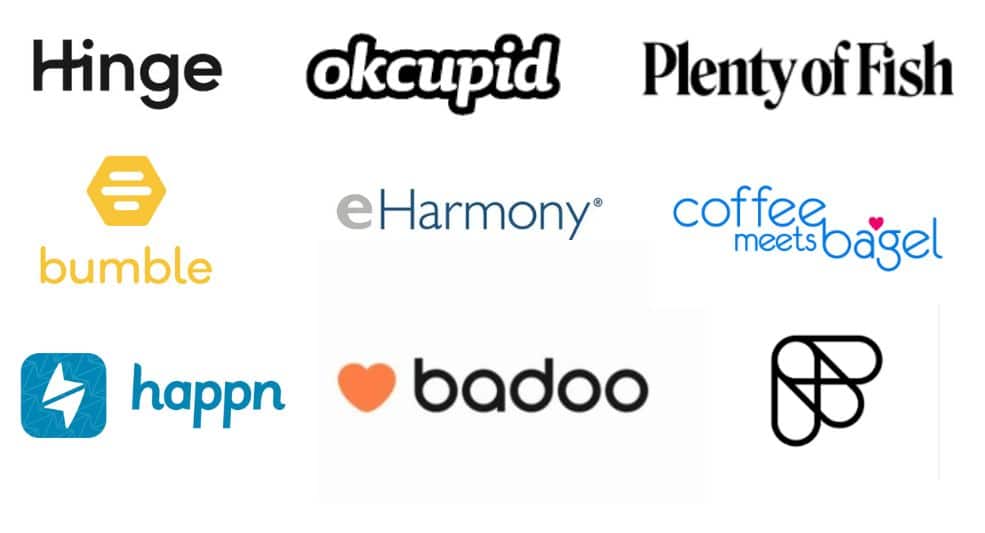
- Hinge: Hinge aims to create meaningful connections by focusing on users’ detailed profiles. It prompts users to answer engaging questions and prompts, facilitating conversation starters beyond just swiping.
Hinge’s interface resembles a social media platform, enabling users to showcase their personalities and interests. - Bumble: Bumble offers a unique twist by putting women in control. It requires women to make the first move, empowering them to initiate conversations. Bumble also features Bumble BFF for finding friendships and Bumble Bizz for professional networking.
- Happn: Happn leverages real-time location data to connect users who have crossed paths in their everyday lives. It shows potential matches based on proximity, adding a serendipitous touch to the dating experience.
Happn encourages users to seize missed connections and turn them into meaningful interactions. - OkCupid: OkCupid focuses on matching users based on their interests, beliefs, and values. It utilizes a comprehensive questionnaire to gather information and employs algorithms to suggest compatible matches.
OkCupid also provides various gender and orientation options, emphasizing inclusivity. - eHarmony: eHarmony is known for its in-depth compatibility matching system. Users go through a detailed questionnaire, and the app uses that information to suggest highly compatible matches.
eHarmony focuses on long-term relationships and has a reputation for attracting individuals seeking serious commitments. - Badoo: Badoo is a popular dating app with a global presence. It offers a combination of dating and social networking features, allowing users to meet new people, chat, and share interests.
Badoo emphasizes the importance of real connections and offers various verification methods to enhance user safety. - Plenty of Fish (POF): POF is a free dating app that offers a large user base and extensive features. It provides users with a range of search filters and communication tools to connect with potential matches.
POF caters to a diverse audience and has both free and paid features. - Coffee Meets Bagel: Coffee Meets Bagel (CMB) emphasizes quality over quantity. Each day, CMB delivers a curated selection of potential matches called “bagels” to its users.
The app encourages thoughtful connections by providing icebreaker questions and limiting the number of profiles users can view each day. - Feeld: Feeld is a dating app for individuals interested in exploring non-traditional relationship dynamics, including polyamory, open relationships, and alternative lifestyles.
It promotes inclusivity and provides a space for users to express their desires and connect with like-minded individuals. - Tastebuds: Tastebuds takes a unique approach to date by connecting users based on their musical preferences. It matches individuals who share similar music tastes, recognizing the power of music in forming connections.
Tastebuds aims to bring people together through their love for music and offers a platform for music discovery and sharing.
Tinder SWOT Analysis
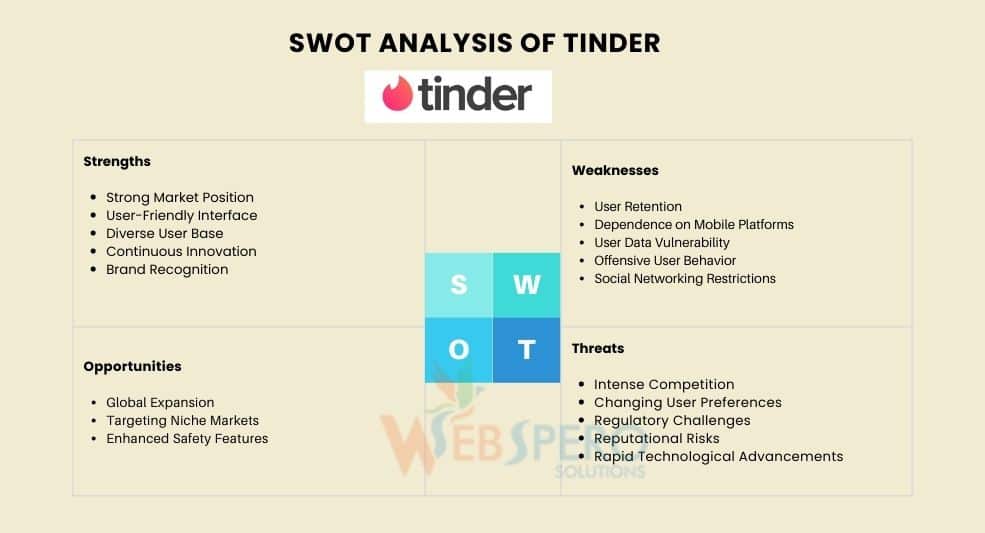
Tinder Business Model Lessons
Tinder’s business model offers several valuable lessons for entrepreneurs and businesses operating in online dating or similar industries:
Freemium Model with Subscription Tiers: Tinder utilizes a freemium model, offering basic features for free while providing additional premium features through subscription tiers (Tinder Plus, Tinder Gold, Tinder Platinum). This approach allows users to experience the app’s core functionality for free while monetizing through subscription fees.
Lesson: Consider offering a freemium model to attract a larger user base and generate revenue through premium features.
Continuous Innovation and Feature Expansion: Tinder consistently introduces new features and updates to enhance the user experience and stay ahead of the competition. They have added features like Super Likes, Boosts, and in-app advertising, as well as integrating with popular platforms like Instagram and Spotify.
Lesson: Prioritize innovation and regularly introduce new features to keep users engaged and differentiate your product.
Targeted Advertising: Tinder leverages its vast user base and user data to provide targeted advertising opportunities to brands. By allowing advertisers to tailor campaigns based on user demographics and preferences, Tinder creates a win-win situation, providing relevant ads to users and generating revenue from advertising partners.
Lesson: Explore targeted advertising options to capitalize on user data and create mutually beneficial partnerships with brands.
Strategic Partnerships: Tinder has formed partnerships with other companies, such as music streaming services, to integrate additional features and enhance the user experience.
Lesson: Seek strategic partnerships that complement your product or service, expanding functionality and attracting new users.
User Safety and Moderation: Tinder has implemented safety features like photo verification and reporting systems to address user concerns regarding offensive behavior and inappropriate content. Prioritizing user safety builds trust and fosters a positive community.
Lesson: Develop robust safety measures and moderation systems to create a safe and respectful environment for users.
International Expansion: Tinder has successfully expanded its user base globally by entering new markets and adapting to regional preferences.
Lesson: Explore opportunities for international expansion, understand cultural nuances, and adapt your product to cater to local preferences.
Brand Building and Recognition: Tinder has established itself as a recognizable and trusted brand in the dating industry through consistent marketing and by delivering a user-friendly experience.
Lesson: Invest in branding efforts to build recognition and trust, creating a strong brand identity that resonates with your target audience.
Conclusion
Tinder’s business model has been instrumental in establishing its dominance in the online dating industry. By prioritizing user experience, continuously innovating features, and leveraging monetization strategies, Tinder has successfully attracted and retained a massive user base.
With its focus on connecting people and creating meaningful relationships, Tinder continues to thrive as a leading platform in the world of online dating.
If you’re inspired by Tinder’s success and looking to venture into the online dating industry, consider developing your own dating app. WebSpero Solutions has a team of experienced professionals that can assist you in developing a high-quality dating app that captures the essence of Tinder while incorporating your unique ideas and preferences.
With our technical expertise and industry knowledge, we can bring your vision to life and help you carve out a successful niche in the competitive online dating industry.
Don’t miss out on the opportunity to capitalize on the ever-growing online dating market. Contact us at WebSpero Solutions today and let’s discuss how we can assist you in creating a remarkable dating app that resonates with users and drives your business forward.
